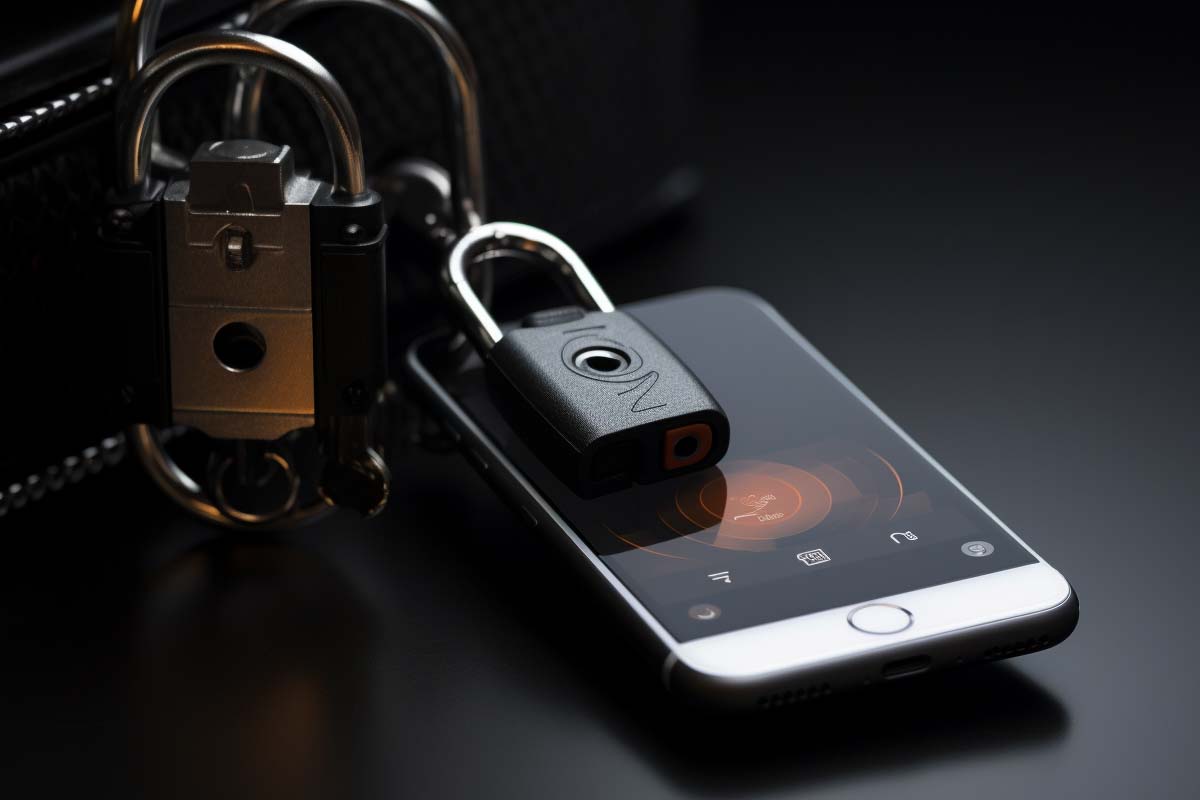Mobile Device Security has become paramount. The digital landscape is increasingly mobile-first, with a significant portion of digital activities taking place on mobile devices. This ubiquity makes mobile devices a prime target for security breaches, emphasizing the critical need for robust mobile device security measures.
Common Security Threats:
- Malware and Viruses: These malicious programs can infiltrate mobile devices, leading to data theft, unauthorized surveillance, or even complete device takeover.
- Phishing Attacks: Cybercriminals often use deceptive emails or messages to trick users into revealing sensitive information. The compact interfaces of mobile devices can make such scams harder to detect.
- Unsecured Networks: Connecting to unsecured Wi-Fi networks can expose your mobile device to interception, allowing cybercriminals to access your personal information.
Understanding these threats is pivotal. Being aware helps in adopting a proactive stance, significantly mitigating the risk of security breaches and ensuring that our mobile devices remain secure fortresses of personal and professional data.

IT User Support Specialist Career Path
View our comprehensive training series covering all the key elements and certifications needed to successfully excel in an IT User Support Specialist job role.
Preventive Measures and Best Practices
A multi-layered approach to security, combining best practices with robust preventive measures, is essential to safeguard mobile devices effectively.
Regular Updates:
- Operating System Updates: Keep your device’s operating system updated. Manufacturers often release updates that patch discovered vulnerabilities.
- App Updates: Regularly updating apps ensures you benefit from the latest security patches and performance improvements.
Safe App Downloads:
- Official App Stores: Always download apps from reputable sources such as the Apple App Store or Google Play. These platforms implement strict security checks to minimize the risk of hosting malicious apps.
Strong Authentication Methods:
- Complex Passwords: Use strong, unique passwords for device access and individual apps, especially those handling sensitive information.
- Biometric Security: Leverage biometric features like fingerprint scanning or facial recognition for an added layer of security.
- Two-Factor Authentication (2FA): Enable 2FA on apps that offer it, adding an extra verification step to ensure that only you can access your accounts.
By integrating these practices into your daily mobile usage, you can significantly enhance the security of your devices, protecting your personal information from potential threats.
Troubleshooting Common Security Issues
Even with preventive measures in place, mobile devices can encounter security issues. Understanding how to identify and resolve these issues is crucial for maintaining the integrity and privacy of your data.
Detecting and Removing Malware:
- Symptoms of Infection: Unusual behavior such as unexpected ads, rapid battery drainage, or increased data usage can indicate malware presence.
- Regular Scans: Use trusted antivirus software to regularly scan your device for malware. These applications can detect and remove malicious software effectively.
- Factory Reset: In extreme cases, a factory reset may be necessary. Ensure you back up important data before proceeding, as this process will erase all data from the device.
Lost or Stolen Device:
- Preventive Measures: Enable features like ‘Find My Device’ for iOS or ‘Find My Mobile’ for Android to track and remotely wipe your device if it’s lost or stolen.
- Immediate Actions: If your device is lost or stolen, immediately change the passwords for your accounts and report the incident to the relevant authorities and your service provider.
Network Security:
- Secure Wi-Fi Usage: Avoid connecting to unsecured public Wi-Fi networks. If necessary, use a reputable VPN to encrypt your data transmission.
- Bluetooth Vigilance: Keep your Bluetooth off when not in use and never accept pairing requests from unknown devices.

Cybersecurity Ethical Hacker
To truly harness the full power of ethical hacking, explore ITU’s outstanding course.
Advanced Security Measures
For those particularly concerned about mobile security, or for corporate users managing sensitive data, advanced security measures can provide additional layers of protection.
Encryption:
- Device Encryption: Most modern smartphones offer full-device encryption. Enabling this feature ensures that your data is unreadable to anyone without the correct authentication.
- Secure Communications: Use encrypted messaging apps for sensitive conversations to protect your data from eavesdroppers.
Secure Browsing:
- Security-Focused Browsers: Consider using browsers that prioritize security and privacy, offering features like tracker blocking and secure connections.
- Avoid Suspicious Links: Be vigilant about the links you click, especially in emails or messages, to avoid phishing sites and other scams.
Regular Backups:
- Data Backup: Regularly back up your device’s data to the cloud or a secure external storage. This ensures that your data can be recovered in case your device is compromised.
Addressing Specific Risks for Business Users
Businesses face unique mobile security challenges, especially with trends like Bring Your Own Device (BYOD). Here are some strategies to manage these risks effectively:
BYOD Policies:
- Clear Guidelines: Implement clear, comprehensive BYOD policies that outline the security expectations for employee-owned devices accessing corporate data.
- Employee Training: Regularly train employees on the importance of mobile security and the best practices to maintain it.
Mobile Device Management (MDM):
- Remote Management: Use MDM solutions to remotely monitor and manage the security of devices accessing corporate data. This includes enforcing security policies and remotely wiping data if a device is lost or stolen.
Employee Training:
- Regular Updates: Keep employees informed about the latest security threats and safe practices through regular training sessions and updates.
- Phishing Awareness: Educate employees on identifying and reporting phishing attempts to prevent data breaches.
By incorporating these advanced security measures and corporate policies, businesses can significantly reduce the risk of mobile security threats and ensure the safe handling of sensitive data.

Lock In Our Lowest Price Ever For Only $14.99 Monthly Access
Your career in information technology last for years. Technology changes rapidly. An ITU Online IT Training subscription offers you flexible and affordable IT training. With our IT training at your fingertips, your career opportunities are never ending as you grow your skills.
Plus, start today and get 10 free days with no obligation.
Latest Trends and Future of Mobile Security
As we venture further into the digital era, the landscape of mobile security continually evolves, with new trends emerging and innovative technologies being developed to counteract sophisticated threats. Here’s a closer look at the latest trends and the future outlook of mobile security:
Emerging Threats
- Deepfake Technology: The rise of deepfake technology poses a significant threat, as it can be used to create convincing fake audios or videos. This could lead to a new wave of phishing attacks that are much harder to identify.
- IoT Device Vulnerabilities: As the Internet of Things (IoT) devices become more prevalent, they also become targets for cyberattacks. Many IoT devices are connected to smartphones, which can serve as a gateway for hackers to access sensitive data.
- 5G Security Concerns: While 5G technology promises faster internet speeds and more reliable connections, it also introduces new security challenges. The increased number of connected devices and the decentralization of networks may give rise to new vulnerabilities.
Technological Advancements
- AI and Machine Learning for Security: Artificial Intelligence (AI) and Machine Learning (ML) are becoming integral in predicting and preventing cyberattacks. These technologies can analyze patterns, detect anomalies, and automatically respond to threats more efficiently than traditional methods.
- Blockchain for Enhanced Security: Blockchain technology is being explored for its potential to enhance mobile security. Its decentralized nature and cryptographic protection can be used for secure transactions, identity verification, and protecting data integrity.
- Biometric Authentication: Advances in biometric authentication, including facial recognition, iris scanning, and fingerprint sensors, are making mobile devices more secure. These methods provide a more robust security layer as they are unique to each individual.
Future Outlook
- Focus on Privacy: With increasing awareness of data privacy issues, future mobile security measures will likely place a greater emphasis on protecting user privacy. This might include more robust encryption methods and regulations that mandate the ethical handling of user data.
- Integrated Security Solutions: As threats become more sophisticated, there’s a growing need for integrated security solutions that offer comprehensive protection. This includes combining network security, endpoint protection, and data security into a unified framework.
- User Education: Recognizing that technology alone cannot prevent cyber threats, there will be a stronger focus on user education. Empowering users to recognize potential threats and understand the importance of security practices will be crucial in enhancing overall security.
As mobile technology continues to advance, staying ahead of these trends and adapting to the evolving security landscape will be crucial. By embracing innovative technologies and maintaining a proactive approach to security, individuals and organizations can safeguard their digital presence against the threats of tomorrow.
Conclusion
In our journey through the intricacies of mobile device security, we’ve uncovered the layers of threats that loom over our digital companions and explored the robust strategies to fortify their defenses. From understanding the basic threats to implementing advanced security measures, and learning from real-world breaches, we’ve equipped ourselves with the knowledge to navigate the complex landscape of mobile security. As technology continues to evolve, so do the threats that target our devices. Therefore, staying informed, vigilant, and proactive is paramount. Remember, the security of your mobile device is not just about protecting a piece of technology, but safeguarding your digital identity, privacy, and data. So, take these lessons, apply the best practices, and stay a step ahead in this ever-evolving digital world.
Frequently Asked Questions About Mobile Device Security
What are the most common threats to mobile device security?
The most common threats include malware, phishing attacks, unsecured Wi-Fi networks, and data leakage through apps and services.
How can I protect my mobile device from malware?
Regularly update your operating system and apps, download apps from official stores only, use reliable antivirus software, and be cautious about the permissions you grant to apps.
Is it safe to use public Wi-Fi networks with my mobile device?
Public Wi-Fi networks can be risky. Avoid transmitting sensitive information over these networks. If necessary, use a reputable VPN to encrypt your data.
How can I prevent data loss if my mobile device is lost or stolen?
Use features like ‘Find My Device’ for iOS or ‘Find My Mobile’ for Android to track and remotely wipe your device. Regularly back up your data, and use strong passwords or biometric locks.
What steps should I take if I suspect my mobile device has been compromised?
Immediately change your passwords, perform a security scan using trusted antivirus software, and monitor your accounts for unusual activity. If necessary, contact your service provider and consider a factory reset to remove any malicious software.
























